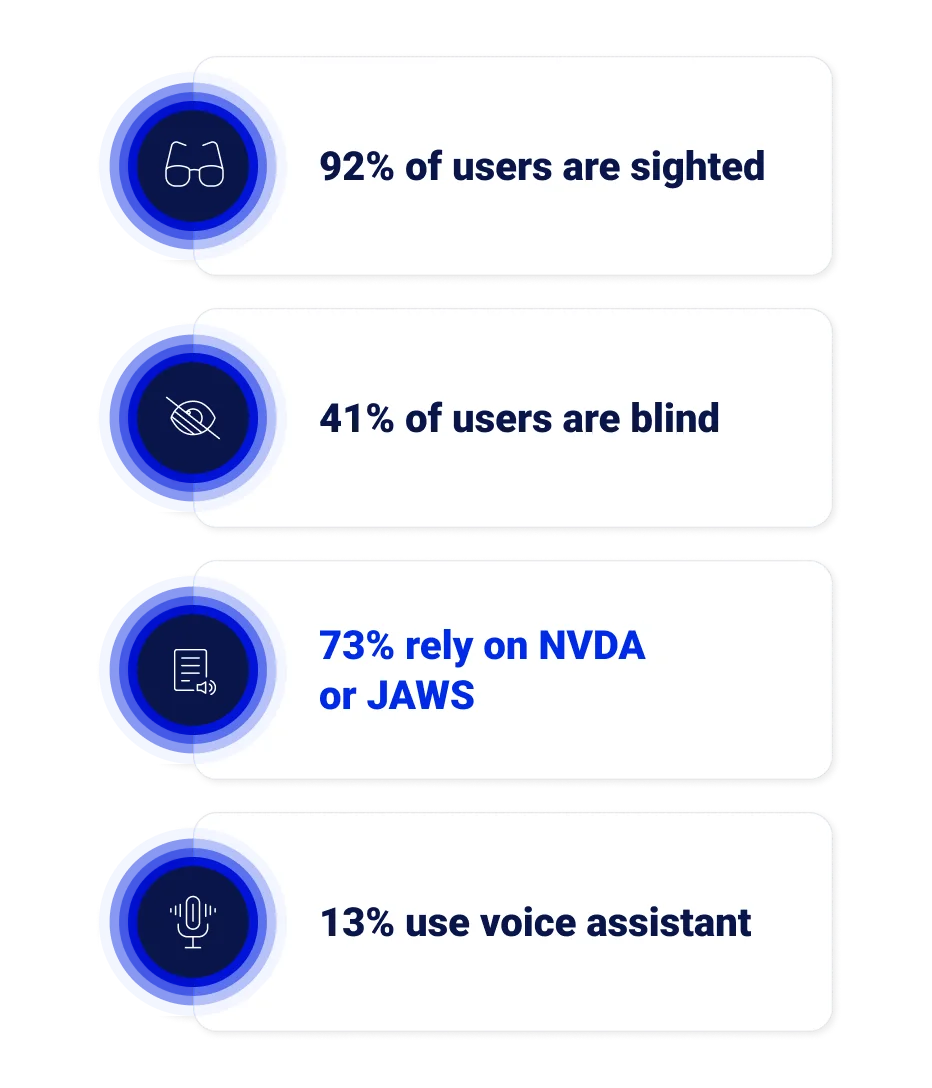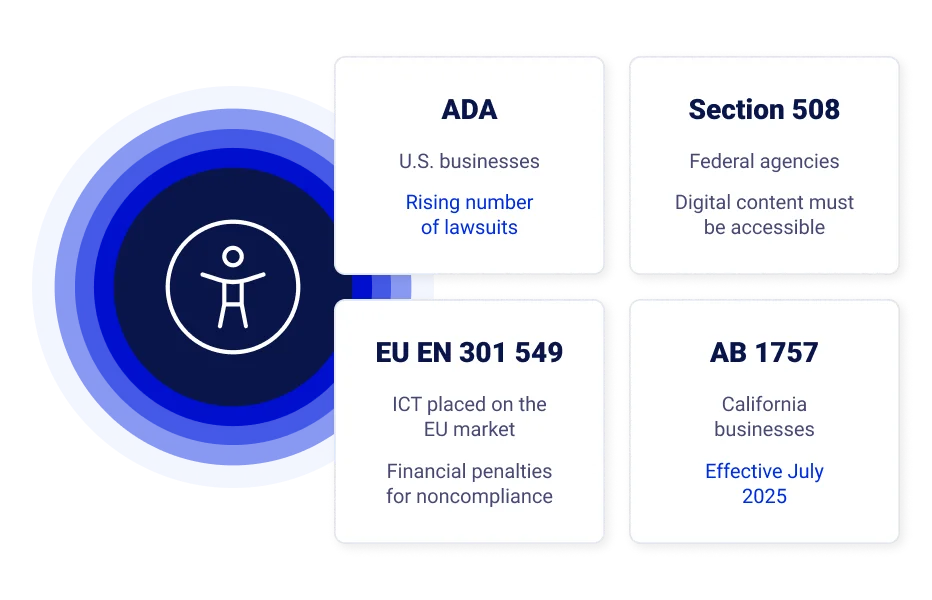Web Accessibility Compliance Guide 2025
Introduction
In 2025, web accessibility is no longer a “nice-to-have.” It’s a business requirement with legal, financial, and reputational consequences. According to the WebAIM Million report, over 96% of websites tested still had WCAG 2.1 failures, showing how widespread barriers remain. That means most businesses today are exposing themselves to lost revenue, user frustration, and the risk of lawsuits.
This guide breaks down what web accessibility means in practice, the major laws shaping requirements in 2025, and the steps businesses can take to improve both usability and legal readiness.
Why It Matters
- Legal risk: Accessibility lawsuits in the U.S. surpassed 4,500 in 2023, with eCommerce and service industries most frequently targeted.
- Customer reach: Over one billion people worldwide live with a disability, representing a huge untapped market segment.
- SEO and performance: Search engines increasingly prioritize accessible sites, meaning accessibility boosts discoverability as well as usability.
For businesses, ignoring accessibility isn’t just risky — it’s expensive. Fixing accessibility proactively is far more cost-effective than defending a lawsuit or losing customers.
For users, the disability statistics speak for themselves:

Core Legal Frameworks in 2025
Several overlapping frameworks guide accessibility obligations:
- ADA (Americans with Disabilities Act, Title III) – Requires businesses providing goods or services online to make them accessible to people with disabilities.
- Section 508 (U.S.) – Applies to federal agencies and contractors, requiring electronic and information technology to meet WCAG standards.
- EN 301 549 (EU) – Establishes ICT accessibility requirements aligned with WCAG.
- WCAG 2.1 and WCAG 2.2 – The technical benchmarks for measuring accessibility. WCAG 2.2 introduces new criteria, such as focus indicators and touch target sizing.

New Accessibility Laws in 2025
While existing frameworks like ADA and WCAG remain central, new laws coming into effect in 2025 expand obligations worldwide:
- European Accessibility Act (EAA)
Who is covered: Businesses offering digital products and services across the EU, including eCommerce, banking, telecom, and transport.
Requirements: Websites, mobile apps, eBooks, and self-service terminals must conform with WCAG and provide usability for people with disabilities.
Penalties: National authorities can impose fines, with enforcement varying by member state. - Accessibility for Ontarians with Disabilities Act (AODA) – 2025 deadline
Who is covered: Public-sector organizations and private businesses with 50+ employees operating in Ontario, Canada.
Requirements: All websites and web content published after 2012 must conform to WCAG 2.0 Level AA.
Penalties: Administrative penalties up to CAD $100,000 per day for corporations and CAD $50,000 per day for individuals/officers. - U.S. Department of Justice ADA Title II Web Accessibility Rule (finalized 2025)
Who is covered: State and local governments (Title II entities).
Requirements: Websites and mobile apps must conform with WCAG 2.1 Level AA.
Penalties: DOJ enforcement actions can include injunctions, consent decrees, and civil penalties up to $75,000 for the first violation and $150,000 for subsequent ones.
What Businesses Must Do
Key accessibility requirements include:
- Provide text alternatives (alt text) for all non-text content.
- Maintain sufficient color contrast for text and graphics.
- Enable keyboard navigation for users who cannot use a mouse.
- Offer captions and transcripts for multimedia.
- Write in clear, consistent language with proper heading structures.
- Check that forms and inputs are labeled correctly and easy to use.
Challenges Businesses Face
- Constantly changing laws: Regulations differ by country and are updated frequently.
- Technical complexity: Accessibility spans design, development, and content.
- Maintenance: Even if a site is accessible today, ongoing changes may reintroduce barriers.
- User feedback: Many businesses lack a structured way to collect and act on accessibility reports.
Staying Ahead with Practical Steps
Businesses can create a realistic roadmap for accessibility in 2025:
- Audit your site against WCAG 2.1/2.2.
- Prioritize fixes that have the biggest impact, such as navigation, contrast, and forms.
- Publish an accessibility statement to communicate your efforts transparently.
- Enable user feedback tools so visitors can report barriers.
- Automate where possible using tools that update as laws evolve.
How Clym Can Help
Clym provides businesses with tools designed to reduce manual effort and simplify accessibility:
- Accessibility Widget – Offers prebuilt adjustments (contrast, font size, keyboard navigation) aligned with WCAG standards.
- Accessibility Issue Reporting – Collects real-world user feedback directly through the site, helping businesses prioritize meaningful fixes.
- Accessibility Statement – Helps businesses publish a clear, legally aligned statement to demonstrate commitment and transparency.
- ReadyCompliance® – Automatically adjust regional settings as accessibility laws evolve across the U.S., EU, and beyond.
Together, these solutions make accessibility a manageable, ongoing process — not just a one-time project.
FAQs
Yes, small businesses are not exempt. Courts have ruled that even small eCommerce websites must be accessible under the ADA.
WCAG 2.2 builds on 2.1 by adding new success criteria, including focus indicators and larger touch targets for mobile usability.
Publishing an accessibility statement and providing users with a way to report issues shows active effort and can reduce reputational risk.
Clym’s widget uses ReadyCompliance® profiles, automatically aligning to laws in different jurisdictions without extra manual setup.
Yes. With Accessibility Issue Reporting, businesses can collect, track, and respond to accessibility feedback directly through the widget.
Absolutely. Search engines reward clean structure, text alternatives, and usable navigation — all of which overlap with accessibility best practices.